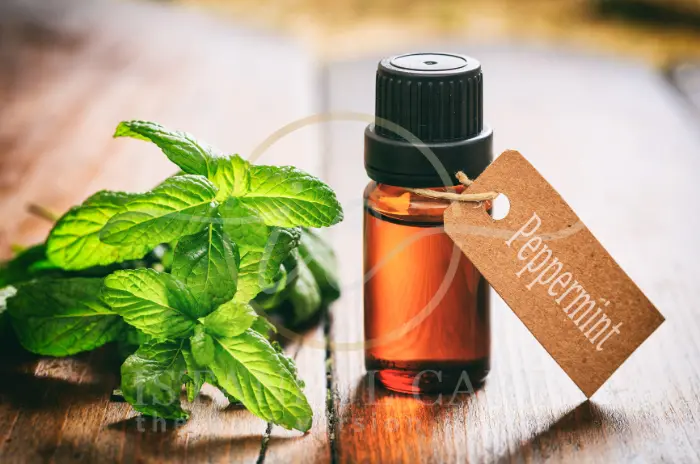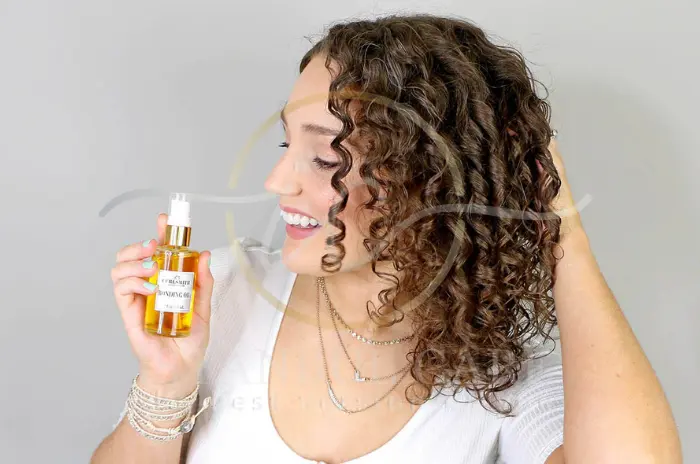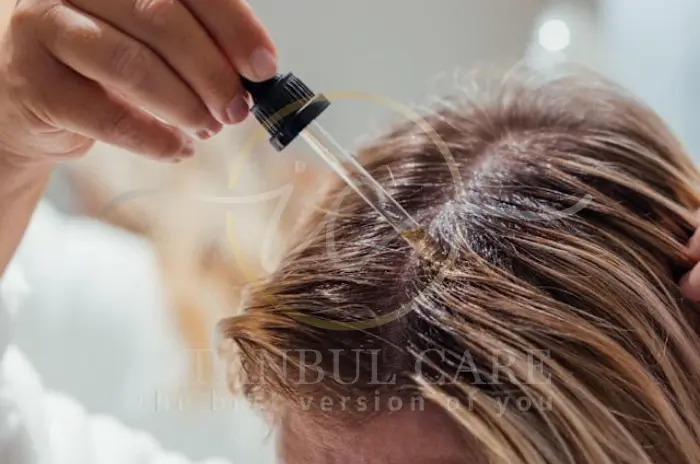Are you searching for natural remedies to boost hair growth and improve your scalp health? Peppermint oil has emerged as one of the most promising essential oils for hair growth, backed by scientific research and countless success stories. This refreshing oil doesn’t just smell amazing – it may actually help combat hair loss, stimulate hair follicles, and create the perfect environment for healthy hair development.
Unlike expensive treatments or harsh chemicals, peppermint oil for hair growth offers a natural, affordable solution that many people are turning to for addressing pattern baldness and thinning hair. Whether you’re dealing with male pattern baldness, dandruff, or simply want thicker, healthier hair, understanding how to properly use this powerful essential oil could be the game-changer you’ve been looking for.

What Is Peppermint Oil?
Peppermint oil is a concentrated extract derived from the peppermint plant (Mentha piperita), a hybrid of watermint and spearmint. This potent essential oil has been used for centuries in traditional medicine and aromatherapy, but recent scientific studies have highlighted its remarkable potential for hair growth and scalp health.
How Peppermint Oil Is Made
The production of high-quality peppermint oil involves steam distillation of fresh peppermint leaves and stems. During this process, steam passes through the plant material, capturing the volatile compounds that give peppermint its distinctive aroma and therapeutic properties. The resulting oil is then separated from the water, creating a concentrated product that contains all the beneficial compounds needed for hair care.
Active Ingredients in Peppermint Oil
The primary active compound in peppermint oil is menthol, which typically comprises 30-50% of the oil’s composition. Menthol is responsible for the cooling sensation and many of the therapeutic benefits associated with peppermint oil for hair. Other important compounds include menthone, menthyl acetate, and cineole, all of which contribute to the oil’s antimicrobial and circulation-boosting properties.
Why It’s Popular in Hair Care
Peppermint oil has gained popularity in hair care due to its unique ability to stimulate blood circulation in the scalp while providing antimicrobial protection. The cooling sensation from menthol helps soothe irritated scalps, while the improved circulation can potentially enhance nutrient delivery to hair follicles. This combination makes it an attractive natural remedy for hair growth that addresses multiple scalp concerns simultaneously.
Benefits of Peppermint Oil for Hair
The benefits of peppermint oil for hair extend far beyond just a refreshing scent. Scientific research and anecdotal evidence suggest that regular use of properly diluted peppermint oil can significantly impact hair health and growth.
Helps Stimulate Hair Growth
Research has shown that topical peppermint oil application can promote hair growth more effectively than some conventional treatments. A notable study found that mice treated with peppermint oil experienced significantly more hair growth compared to those treated with saline, jojoba oil, or even minoxidil. The oil’s ability to increase blood flow to hair follicles may help deliver essential nutrients needed for healthy hair development.
Improves Scalp Circulation
One of the most significant benefits of peppermint oil for hair is its ability to enhance scalp circulation. When applied to the scalp, menthol creates a vasodilating effect, widening blood vessels and increasing blood flow. This improved circulation can help ensure that hair follicles receive adequate oxygen and nutrients, creating an optimal environment for hair growth.
Fights Dandruff and Itching
Peppermint oil for dandruff treatment is particularly effective due to its antimicrobial and antifungal properties. The oil can help combat the fungi and bacteria that often contribute to dandruff formation. Additionally, the cooling sensation provides immediate relief from itching and irritation, making it an excellent choice for those dealing with scalp discomfort.
Boosts Circulation to Hair Follicles
The menthol in peppermint oil acts as a natural vasodilator, meaning it helps widen blood vessels and improve circulation. When used in a peppermint hair massage, this increased blood flow can help deliver vital nutrients directly to hair follicles, potentially supporting stronger, healthier hair growth and reducing hair loss.
How to Use Peppermint Oil on Hair
Understanding how to use peppermint oil on hair safely and effectively is crucial for achieving the best results while avoiding potential irritation. Proper application techniques can maximize the benefits while minimizing risks.
Diluting Peppermint Oil Safely
Safe peppermint oil usage always requires proper dilution with a carrier oil such as jojoba oil, coconut oil, or olive oil. A typical dilution ratio is 2-3 drops of peppermint oil per tablespoon of carrier oil. This ratio provides therapeutic benefits while reducing the risk of skin irritation that can occur with undiluted essential oils.
Scalp Massage Techniques
A proper peppermint hair massage involves gently working the diluted oil into the scalp using circular motions with your fingertips. Start at the hairline and work your way back, spending extra time on areas where hair loss is most noticeable. Massage for 5-10 minutes to ensure good penetration and circulation stimulation.
Mixing with Other Oils
Peppermint oil can be combined with other beneficial oils to enhance its effects. Popular combinations include mixing it with rosemary oil for additional hair growth benefits, or with tea tree oil for enhanced antimicrobial properties. When creating blends, maintain the same dilution ratios to ensure safety.
How Often Should You Use It?
For optimal results, how often should you use peppermint oil on hair depends on your scalp’s sensitivity and hair type. Most people can safely use diluted peppermint oil 2-3 times per week. Start with once weekly applications to assess your skin’s tolerance, then gradually increase frequency if no irritation occurs.
DIY Peppermint Oil Hair Treatments
Creating your own peppermint oil hair mask recipe is simple and cost-effective. Mix 3-4 drops of peppermint oil with 2 tablespoons of jojoba oil and 1 tablespoon of honey for a nourishing treatment. Apply to damp hair and scalp, leave for 20-30 minutes, then rinse thoroughly with shampoo.
Side Effects and Safety Tips
While peppermint oil is generally safe when used properly, understanding potential peppermint oil side effects is essential for safe usage. Proper precautions can help you enjoy the benefits while avoiding adverse reactions.
Who Should Avoid Peppermint Oil
Certain individuals should exercise caution or avoid peppermint oil for hair altogether. Pregnant and breastfeeding women should consult healthcare providers before use. People with sensitive skin, eczema, or other scalp conditions may experience increased irritation and should perform thorough patch testing.
Allergic Reactions and Irritation
Peppermint oil side effects can include redness, burning sensations, or allergic reactions in sensitive individuals. Symptoms may include itching, swelling, or rash formation. If any adverse reactions occur, discontinue use immediately and rinse the affected area thoroughly with cool water.
Recommended Dosage for Hair Applications
The recommended dosage for hair applications should never exceed 2-3% concentration when mixed with carrier oils. For most people, this translates to 2-3 drops of peppermint oil per tablespoon of carrier oil. Higher concentrations increase the risk of irritation without providing additional benefits.
Common Risks and Reactions
Common risks include scalp irritation, excessive dryness, or burning sensations if the oil is applied undiluted or in excessive concentrations. Some people may experience headaches from the strong menthol aroma, especially in poorly ventilated areas.
Patch Test Before Use
Always perform a patch test before use by applying a small amount of diluted peppermint oil to a discrete area of skin, such as behind the ear or on the inner wrist. Wait 24-48 hours to observe any reactions before applying to your scalp or hair.

Is Peppermint Oil Good for All Hair Types?
Peppermint oil for hair effectiveness can vary depending on individual hair types and scalp conditions. Understanding how it affects different hair textures and scalp types helps determine if it’s suitable for your specific needs.
Effects on Curly or Coily Hair
Peppermint oil can be particularly beneficial for curly or coily hair types that often struggle with dry scalps and frizzy hair. The oil’s moisturizing properties, when combined with appropriate carrier oils, can help reduce frizz while promoting scalp health. However, those with very dry hair should use it sparingly and focus primarily on scalp application.
Suitability for Oily or Dry Scalps
For oily scalps, peppermint oil can help regulate sebum production while providing antimicrobial benefits. Those with dry scalps should use it more cautiously, ensuring adequate dilution and focusing on carrier oils with moisturizing properties like jojoba oil or argan oil.
Does Peppermint Oil Really Help Hair Growth?
The question “Can peppermint oil regrow hair like minoxidil?” has gained significant attention as more people seek natural hair growth remedies. Scientific evidence suggests that peppermint oil may indeed be effective for promoting hair growth.
Research indicates that peppermint oil application can lead to measurable improvements in hair growth rates, hair thickness, and overall scalp health. The mechanisms behind these effects include improved circulation, antimicrobial action, and potential hormone regulation that may help address pattern baldness.
Scientific Evidence on Peppermint Oil and Hair Health
Multiple studies have investigated peppermint oil effects on hair growth and scalp health, providing valuable insights into its therapeutic potential.
Key Findings from Peppermint Oil Studies
A landmark study published in Toxicological Research found that topical peppermint oil application resulted in remarkable hair growth improvements. Subjects treated with peppermint oil showed significantly increased hair growth compared to control groups, with some experiencing growth rates exceeding those achieved with minoxidil applications.
How Peppermint Oil Compares to Other Essential Oils
When comparing peppermint oil vs rosemary oil, both show promise for hair growth, but through different mechanisms. While peppermint oil primarily works through circulation enhancement, rosemary oil may help block DHT production. Many users combine both oils for comprehensive hair loss prevention.
| Essential Oil | Primary Mechanism | Best For | Application Frequency | Dilution Ratio |
|---|---|---|---|---|
| Peppermint Oil | Circulation enhancement, menthol cooling | Hair growth, scalp stimulation, dandruff | 2-3 times per week | 2-3 drops per tbsp carrier oil |
| Rosemary Oil | DHT blocking, antioxidant properties | Male pattern baldness, thinning hair | 3-4 times per week | 3-4 drops per tbsp carrier oil |
| Lavender Oil | Stress reduction, antimicrobial action | Scalp soothing, hair growth support | Daily application safe | 4-5 drops per tbsp carrier oil |
| Tea Tree Oil | Strong antimicrobial, deep cleansing | Dandruff, scalp infections, oily scalp | 1-2 times per week | 1-2 drops per tbsp carrier oil |
| Cedarwood Oil | Hormone balancing, circulation boost | Hair loss prevention, alopecia | 2-3 times per week | 2-3 drops per tbsp carrier oil |
Comparing Peppermint Oil with Minoxidil
The comparison between peppermint oil and minoxidil reveals interesting findings about natural remedies for hair growth. While minoxidil remains the gold standard for hair loss treatment, peppermint oil offers several advantages including fewer side effects, lower cost, and additional scalp health benefits.
Studies suggest that peppermint oil may produce comparable or even superior hair growth results compared to minoxidil, though more human trials are needed to establish definitive comparisons. The natural approach appeals to those seeking natural remedies for hair loss without pharmaceutical interventions.
| Treatment Aspect | Peppermint Oil | Minoxidil |
|---|---|---|
| Effectiveness | Comparable hair growth results in studies | Clinically proven for hair growth |
| Side Effects | Minimal when properly diluted | Scalp irritation, unwanted facial hair growth |
| Cost | Very affordable ($10-20 per bottle) | Moderate to expensive ($20-60 monthly) |
| Application | 2-3 times weekly with peppermint hair massage | Twice daily application required |
| Additional Benefits | Dandruff control, scalp health, antimicrobial | Primarily hair growth focused |
| Time to Results | 2-4 months for visible improvement | 3-6 months for noticeable results |
| Withdrawal Effects | No dependency, gradual benefits | Hair loss resumes if discontinued |
| Scalp Tolerance | Generally well-tolerated when diluted | May cause dryness, flaking, irritation |

How to Apply Peppermint Oil to Your Hair
Proper application techniques are crucial for maximizing peppermint oil benefits for hair while ensuring safety and effectiveness.
Blending with Carrier Oils
Choosing high-quality peppermint oil for hair and blending it with appropriate carrier oils creates the foundation for effective treatment. Popular carrier options include jojoba oil, coconut oil, argan oil, and sweet almond oil. Each carrier oil provides unique benefits that complement peppermint oil’s effects.
Direct Scalp Massage Technique
The direct scalp massage technique involves applying the diluted oil mixture directly to the scalp using gentle, circular motions. Focus on areas experiencing hair loss or thinning, spending 5-10 minutes massaging to ensure good penetration and circulation stimulation.
Using It in Hair Masks or Rinses
Peppermint oil hair rinse treatments can be created by adding a few drops to your regular shampoo or creating a post-wash rinse. For hair masks, combine peppermint oil with nourishing ingredients like honey, avocado, or yogurt for comprehensive hair care.
What to Know Before Using Peppermint Oil
Several important considerations should guide your peppermint oil usage to ensure optimal results and safety.
How Often Should You Use Peppermint Oil on Hair?
How often should you use peppermint oil on hair depends on your scalp’s tolerance and specific hair goals. Most people achieve best results with 2-3 weekly applications, allowing time for the scalp to respond without over-stimulation.
Choosing High-Quality Peppermint Oil for Hair
Choosing high-quality peppermint oil for hair requires attention to purity, extraction methods, and source quality. Look for 100% pure, therapeutic-grade oils from reputable suppliers who provide detailed information about their extraction and testing processes.
Proper Dilution Ratios for Peppermint Oil
Proper dilution ratios for peppermint oil typically range from 1-3% concentration in carrier oils. For beginners, start with 1% concentration (1 drop per teaspoon of carrier oil) and gradually increase if well-tolerated.
Signs You Might Be Using Too Much Peppermint Oil
Signs you might be using too much peppermint oil include persistent burning sensations, excessive dryness, irritation, or headaches. If these symptoms occur, reduce concentration or frequency of application.
Peppermint Oil vs Other Essential Oils for Hair
Understanding how peppermint oil compares to other essential oils for hair care helps you make informed decisions about your hair growth strategy.
Peppermint Oil or Rosemary Oil: Which is Better?
The debate between peppermint oil or rosemary oil for hair growth doesn’t have a simple answer. Peppermint oil excels at circulation enhancement and immediate scalp stimulation, while rosemary oil may provide better DHT-blocking properties for male pattern baldness. Many users find success combining both oils.
Combining Peppermint Oil with Other Hair Oils
Combining peppermint oil with other hair oils can create synergistic effects that address multiple aspects of hair health. Popular combinations include peppermint with lavender for scalp soothing, or with cedarwood for additional hair growth support.
Who Should Use Peppermint Oil and When to Skip It
Understanding who can benefit most from peppermint oil for hair helps determine if it’s appropriate for your specific situation.
Ideal Candidates: Oily or Normal Scalps
Ideal candidates for peppermint oil treatment typically have oily or normal scalp types that can tolerate the oil’s stimulating effects. Those experiencing early-stage hair loss, pattern baldness, or scalp circulation issues often see the most dramatic improvements.
Warnings for Dry, Brittle Hair or Sensitive Skin
Warnings for dry, brittle hair or sensitive skin include the potential for increased dryness or irritation. People with these conditions should use extra caution, lower concentrations, and more moisturizing carrier oils.
How to Patch Test and Avoid Irritation
How to patch test and avoid irritation involves applying a small amount of diluted oil to a test area and waiting 24-48 hours for any reactions. Always start with lower concentrations and gradually increase as tolerated.
What Makes Peppermint Oil Good for Hair Growth?
The mechanisms behind peppermint oil’s effectiveness for hair growth involve multiple pathways that support scalp health and hair follicle function.
Menthol’s Effect on Scalp Circulation
Menthol’s effect on scalp circulation is the primary mechanism driving peppermint oil’s hair growth benefits. The vasodilating effect increases blood flow, delivering more nutrients and oxygen to hair follicles while removing metabolic waste products.
Cooling and Antimicrobial Properties
The cooling and antimicrobial properties of peppermint oil create an optimal scalp environment for hair growth. The antimicrobial action helps prevent infections that can damage hair follicles, while the cooling effect soothes inflammation that may impede hair growth.
Speak with our expert Hair Transplantation specialists

Speak with our expert Hair Transplantation specialists
We’re ready to answer your questions
FAQs for Peppermint Oil for Hair Growth and Scalp Health
Yes, scientific studies have shown that peppermint oil can effectively stimulate hair growth through improved scalp circulation and hair follicle activation.
Always dilute peppermint oil to 1-3% concentration, using 2-3 drops per tablespoon of carrier oil like jojoba oil.
Yes, peppermint oil for dandruff is effective due to its antimicrobial properties and cooling sensation that soothes scalp irritation.
Most people can safely use diluted peppermint oil 2-3 times per week for optimal hair growth benefits.
Peppermint oil works best for normal to oily scalp types, while those with sensitive or very dry scalps should use it cautiously.
Studies suggest peppermint oil may produce comparable hair growth results to minoxidil with fewer side effects.
While peppermint oil primarily works through circulation enhancement, it may have some DHT-blocking properties, though rosemary oil is more studied for this effect.
Watch for skin irritation, burning sensations, excessive dryness, or allergic reactions when using peppermint oil for hair growth.

